Multi-Objective Evolution and Swarm-Integrated Optimization of Manufacturing Processes in Simulation-Based Environments
Abstract
1. Introduction
- A multi-objective evolutionary and swarm-integrated framework is proposed to optimize digital twins of manufacturing systems. The optimization intends to balance the number of WIP along with improvements in service level, resource management, and cost-effectiveness. Such an approach will provide holistic improvements in system performance.
- Four widely known optimization algorithms, including genetic algorithms and proximal swarm optimization, are compared and evaluated under real-world-like fluctuating manufacturing events. This comparison provides a critical evaluation of the algorithms’ performance in a simulated environment.
- Robust solutions are determined through a three-stage filtering methodology. This methodology utilizes a variety of pull and push production control mechanisms, such as Kanban and Base Stock, to generate an initial set of solutions. These solutions are afterward assessed on the basis of the simulation output, inventory levels, and production control overhead.
- Experimental analysis reveals useful insights into the performance of hybrid production control optimization frameworks in terms of sustainability, resilience, resource management, and throughput. It demonstrates the benefits of the proposed holistic production optimization framework.
2. Related Work
3. Material and Methods
3.1. Manufacturing System
3.2. Multi-Objective Optimization Problem
- HK-CONWIP:
- BK-CONWIP:
- HK-CONWIP:
- BK-CONWIP:
3.3. Optimization Method
3.3.1. JaamSim
- The transfer time for the cards and processed items is negligible.
- The system consists of 3 processing stages involving similar machines with unlimited capacity in the queues for processing.
- In each queue, the components are arranged in FIFO order, and one unit is processed at a time.
- The orders for each product are placed by different customers.
- A production week is considered 96 h (6 days × 16 h).
- Lost sales are considered the pending orders that remain unsatisfied when the system has more than 5 production requests in the queue of the 3rd stage, and simultaneously, there is no available inventory of finished goods.
- The probability of product returns is defined by a normal distribution with values ranging from [0.005–0.1] and a mean of 0.02.
3.3.2. Optimization Algorithms
- The first stage is focused on generating a pool of candidate solutions according to the performance of the digital twins in JaamSim 2024-09. We used the Pareto front for non-dominated solutions to identify the optimal trade-offs between the competing objectives, according to the service level, the inventory, and the profit . This methodology produces a pool of optimal, or near-optimal, solutions used in the subsequent stages.
- The second stage is based on defining the total number of cards, which correspond to Kanban and CONWIP-based policies. Initially, using the pool of solutions generated in the first stage, the average values of the cards of CONWIP and Kanban are calculated. A function is used to evaluate which ones manage to have a value lower than the average. The filtered solutions are transferred to the last step.
- The final step involves the definition of the quantity of initial stock. Using the remaining solutions, the average quantity is calculated. The solution that achieved the smallest average initial stock is retained. This ensures that the digital twins under the selected solutions are resource-efficient by minimizing the initial resources and maintaining high-quality output.
| Algorithm 1 Multi-Objective Optimization and Execution in JaamSim |
| Require: Objective functions |
| Require: Decision variables with bounds |
| Require: Optimization algorithm |
| Require: JaamSim model |
| Require: Maximum iterations |
|
4. Experimental Analysis
4.1. Setup
4.2. Performance
5. Conclusions
Author Contributions
Funding
Data Availability Statement
Conflicts of Interest
References
- Paraschos, P.D.; Koulouriotis, D.E. Learning-based production, maintenance, and quality optimization in smart manufacturing systems: A literature review and trends. Comput. Ind. Eng. 2024, 198, 110656. [Google Scholar] [CrossRef]
- Park, K.T.; Son, Y.H.; Ko, S.W.; Noh, S.D. Digital Twin and Reinforcement Learning-Based Resilient Production Control for Micro Smart Factory. Appl. Sci. 2021, 11, 2977. [Google Scholar] [CrossRef]
- Samsonov, V.; Hicham, K.B.; Meisen, T. Reinforcement Learning in Manufacturing Control: Baselines, challenges and ways forward. Eng. Appl. Artif. Intell. 2022, 112, 104868. [Google Scholar] [CrossRef]
- Sharma, A.; Kosasih, E.; Zhang, J.; Brintrup, A.; Calinescu, A. Digital Twins: State of the art theory and practice, challenges, and open research questions. J. Ind. Inf. Integr. 2022, 30, 100383. [Google Scholar] [CrossRef]
- Ivanov, D. Conceptual and formal models for design, adaptation, and control of digital twins in supply chain ecosystems. Omega 2025, 137, 103356. [Google Scholar] [CrossRef]
- Loaiza, J.H.; Cloutier, R.J. Analyzing the Implementation of a Digital Twin Manufacturing System: Using a Systems Thinking Approach. Systems 2022, 10, 22. [Google Scholar] [CrossRef]
- Yao, J.F.; Yang, Y.; Wang, X.C.; Zhang, X.P. Systematic review of digital twin technology and applications. Vis. Comput. Ind. Biomed. Art 2023, 6, 10. [Google Scholar] [CrossRef] [PubMed]
- Belo, R.C.; Pimenta, M.S.; Salvador, T.T.; Petry, R.H.; Abel, M. Fundamental requirements of Digital Twins for production system in Oil and Gas Industry: A systematic literature review. Inf. Softw. Technol. 2025, 184, 107742. [Google Scholar] [CrossRef]
- Gaspar-Cunha, A.; Melo, J.; Marques, T.; Pontes, A. A Review on Injection Molding: Conformal Cooling Channels, Modelling, Surrogate Models and Multi-Objective Optimization. Polymers 2025, 17, 919. [Google Scholar] [CrossRef] [PubMed]
- Kober, C.; Buxbaum-Conradi, S.; Fette, M.; Wulfsberg, J.P. Digital Twins: A Critical Perspective and Research Trends. In Proceedings of the 2024 IEEE International Conference on Industrial Engineering and Engineering Management (IEEM), Bangkok, Thailand, 15–18 December 2024; pp. 749–754. [Google Scholar] [CrossRef]
- Malik, S.; Kim, D. Improved Control Scheduling Based on Learning to Prediction Mechanism for Efficient Machine Maintenance in Smart Factory. Actuators 2021, 10, 27. [Google Scholar] [CrossRef]
- Ata, M.; Corum, A. The Impact of Return Disposal on Order Variance in a Hybrid Manufacturing and Remanufacturing System. IEEE Trans. Eng. Manag. 2022, 70, 2574–2583. [Google Scholar] [CrossRef]
- Onyeocha, C.E.; Khoury, J.; Geraghty, J. A comparison of Kanban-Like control strategies in a multi-product manufacturing system under erratic demand. In Proceedings of the 2013 IEEE Winter Simulations Conference (WSC), Washington, DC, USA, 8–11 December 2013; pp. 2730–2741. [Google Scholar] [CrossRef]
- Paraschos, P.D.; Koulinas, G.K.; Koulouriotis, D.E. Reinforcement Learning-Based Optimization for Sustainable and Lean Production within the Context of Industry 4.0. Algorithms 2024, 17, 98. [Google Scholar] [CrossRef]
- Chen, Z.; Zou, J.; Wang, W. Digital twin-oriented collaborative optimization of fuzzy flexible job shop scheduling under multiple uncertainties. Sādhanā 2023, 48, 78. [Google Scholar] [CrossRef]
- Ricondo, I.; Porto, A.; Ugarte, M. A digital twin framework for the simulation and optimization of production systems. Procedia CIRP 2021, 104, 762–767. [Google Scholar] [CrossRef]
- Mei, S.; Xie, Y.; Liu, J.; Wu, J.; Zhang, C. Physics-based modeling and intelligent optimal decision method for digital twin system towards sustainable CNC equipment. Robot. Comput.-Integr. Manuf. 2025, 95, 103028. [Google Scholar] [CrossRef]
- O’Connell, E.; O’Brien, W.; Bhattacharya, M.; Moore, D.; Penica, M. Digital Twins: Enabling Interoperability in Smart Manufacturing Networks. Telecom 2023, 4, 265–278. [Google Scholar] [CrossRef]
- Moiceanu, G.; Paraschiv, G. Digital Twin and Smart Manufacturing in Industries: A Bibliometric Analysis with a Focus on Industry 4.0. Sensors 2022, 22, 1388. [Google Scholar] [CrossRef] [PubMed]
- Liu, Q.; Wang, X.; Guan, Z.; Li, Z.; Yang, L. Ply Optimization of Composite Laminates for Processing-Induced Deformation and Buckling Eigenvalues Based on Improved Genetic Algorithm. Materials 2025, 18, 345. [Google Scholar] [CrossRef] [PubMed]
- Peng, S.; Du, L.; Che, L.; Jin, Z. Dimensional multi-objective optimization design for 2RPU-RPS parallel mechanism. Robotica 2025, 43, 1087–1109. [Google Scholar] [CrossRef]
- Ren, J.; Wang, S.; Ren, K. Multi-objective optimization of grinding process parameters for complicated worm space surface based on the grey wolf optimization algorithm. Adv. Mech. Eng. 2025, 17. [Google Scholar] [CrossRef]
- Fu, Y.; Zhou, M.; Guo, X.; Qi, L.; Gao, K.; Albeshri, A. Multiobjective Scheduling of Energy-Efficient Stochastic Hybrid Open Shop with Brain Storm Optimization and Simulation Evaluation. IEEE Trans. Syst. Man Cybern. Syst. 2024, 54, 4260–4272. [Google Scholar] [CrossRef]
- Tran, L.V.; Huynh, B.H.; Akhtar, H. Ant Colony Optimization Algorithm for Maintenance, Repair and Overhaul Scheduling Optimization in the Context of Industrie 4.0. Appl. Sci. 2019, 9, 4815. [Google Scholar] [CrossRef]
- Wei, T.; Guo, X.; Zhou, M.; Wang, J.; Liu, S.; Qin, S.; Tang, Y. A Multiobjective Discrete Harmony Search Optimizer for Disassembly Line Balancing Problems Considering Human Factors. IEEE Trans. Hum.-Mach. Syst. 2025, 55, 124–133. [Google Scholar] [CrossRef]
- Jung, J.; Park, K.; Lee, H.; Cho, B.; Ryu, S. Comparative Study of Multi-objective Bayesian Optimization and NSGA-III based Approaches for Injection Molding Process. Adv. Theory Simul. 2024, 7, 2400135. [Google Scholar] [CrossRef]
- Babor, M.; Pedersen, L.; Kidmose, U.; Paquet-Durand, O.; Hitzmann, B. Application of Non-Dominated Sorting Genetic Algorithm (NSGA-II) to Increase the Efficiency of Bakery Production: A Case Study. Processes 2022, 10, 1623. [Google Scholar] [CrossRef]
- Baghizadeh, K.; Ebadi, N.; Zimon, D.; Jum’a, L. Using Four Metaheuristic Algorithms to Reduce Supplier Disruption Risk in a Mathematical Inventory Model for Supplying Spare Parts. Mathematics 2022, 11, 42. [Google Scholar] [CrossRef]
- Guo, S.; Huang, Y.; Guo, J.; Peng, Z.; Du, B. Modeling and optimization of batch scheduling problem considering the process granularity in shared manufacturing. Comput. Ind. Eng. 2025, 205, 111198. [Google Scholar] [CrossRef]
- Bi, Y.; Ning, X.; Zhao, S. Optimization of stamping workshop line layout based on improved PSO algorithm. Discov. Appl. Sci. 2025, 7, 267. [Google Scholar] [CrossRef]
- Hou, Y.; Liao, X.; Chen, G.; Chen, Y. Co-Evolutionary NSGA-III with deep reinforcement learning for multi-objective distributed flexible job shop scheduling. Comput. Ind. Eng. 2025, 203, 110990. [Google Scholar] [CrossRef]
- Vaidya, S.; Jethava, G. Elevating manufacturing excellence with multilevel optimization in smart factory cloud computing using hybrid model. Clust. Comput. 2025, 28, 342. [Google Scholar] [CrossRef]
- Novarika, W.; Sinaga, S.B.; Prayogi, S.Y. Reducing operational costs in a manufacturing system that incorporates quality assurances, probabilistic failures, overtime and outsourcing. East.-Eur. J. Enterp. Technol. 2024, 4, 19–30. [Google Scholar] [CrossRef]
- Qu, L.; Liao, J.; Gao, K.; Yang, L. Joint Optimization of Production Lot Sizing and Preventive Maintenance Threshold Based on Nonlinear Degradation. Appl. Sci. 2022, 12, 8638. [Google Scholar] [CrossRef]
- Paraschos, P.D.; Gasteratos, A.C.; Koulouriotis, D.E. Deep learning model for optimizing control and planning in stochastic manufacturing environments. Expert Syst. Appl. 2024, 257, 125075. [Google Scholar] [CrossRef]
- Paraschos, P.D.; Xanthopoulos, A.S.; Koulinas, G.K.; Koulouriotis, D.E. Machine learning integrated design and operation management for resilient circular manufacturing systems. Comput. Ind. Eng. 2022, 167, 107971. [Google Scholar] [CrossRef]
- Onyeocha, C.E.; Wang, J.; Khoury, J.; Geraghty, J. A comparison of HK-CONWIP and BK-CONWIP control strategies in a multi-product manufacturing system. Oper. Res. Perspect. 2015, 2, 137–149. [Google Scholar] [CrossRef]
- Thomopoulos, N.T. Standard Normal and Truncated Normal Distributions. In Demand Forecasting for Inventory Control; Springer International Publishing: Cham, Switzerland, 2015; pp. 137–148. [Google Scholar] [CrossRef]
- Borucka, A.; Kozłowski, E.; Antosz, K.; Parczewski, R. A New Approach to Production Process Capability Assessment for Non-Normal Data. Appl. Sci. 2023, 13, 6721. [Google Scholar] [CrossRef]
- Abid, M.; Sun, M.; Shabbir, A.; Bakr, M.E.; Abbas, T. An enhanced nonparametric quality control chart with application related to industrial process. Sci. Rep. 2024, 14, 13561. [Google Scholar] [CrossRef] [PubMed]
- Blank, J.; Deb, K. Pymoo: Multi-Objective Optimization in Python. IEEE Access 2020, 8, 89497–89509. [Google Scholar] [CrossRef]


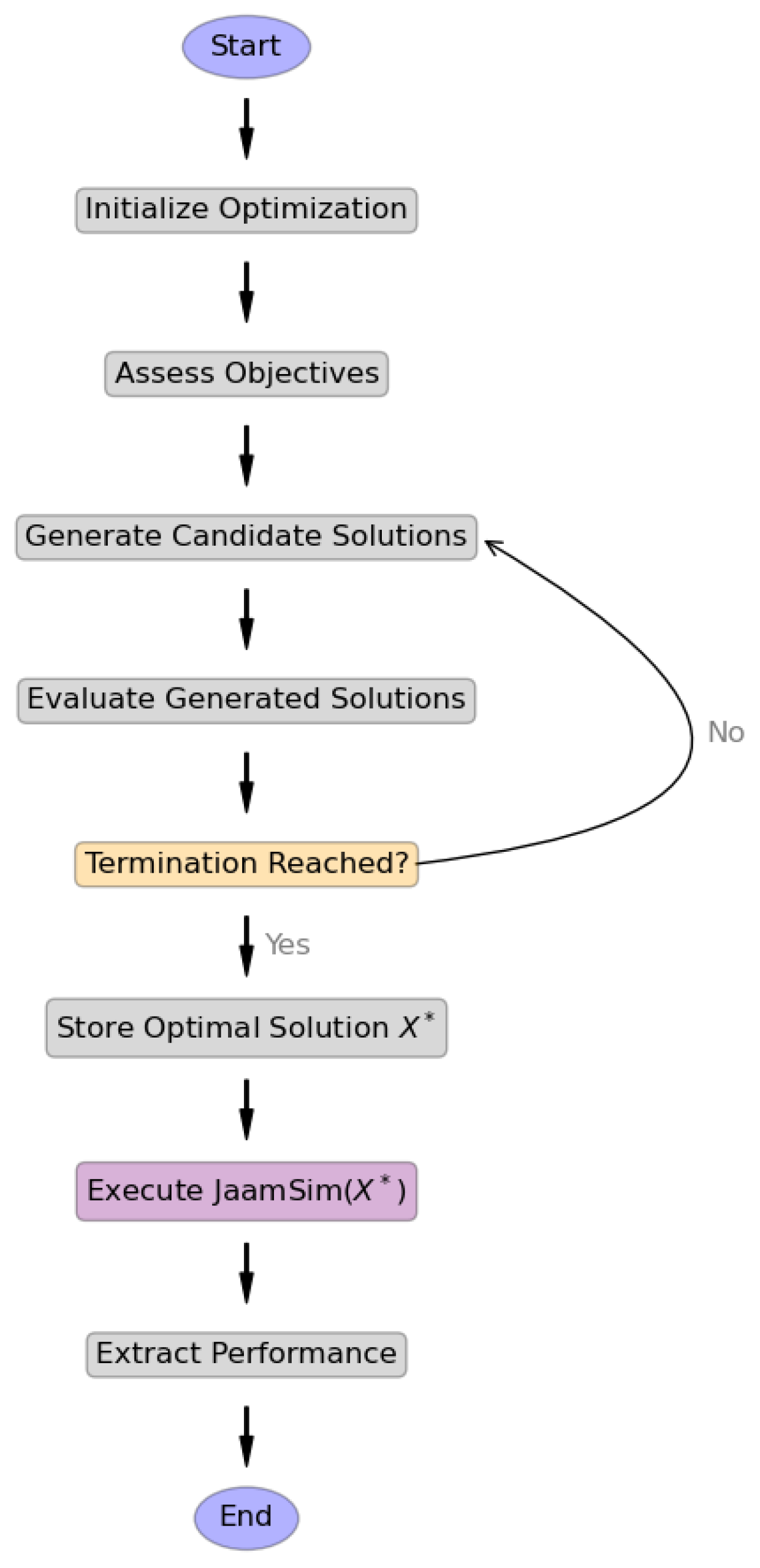

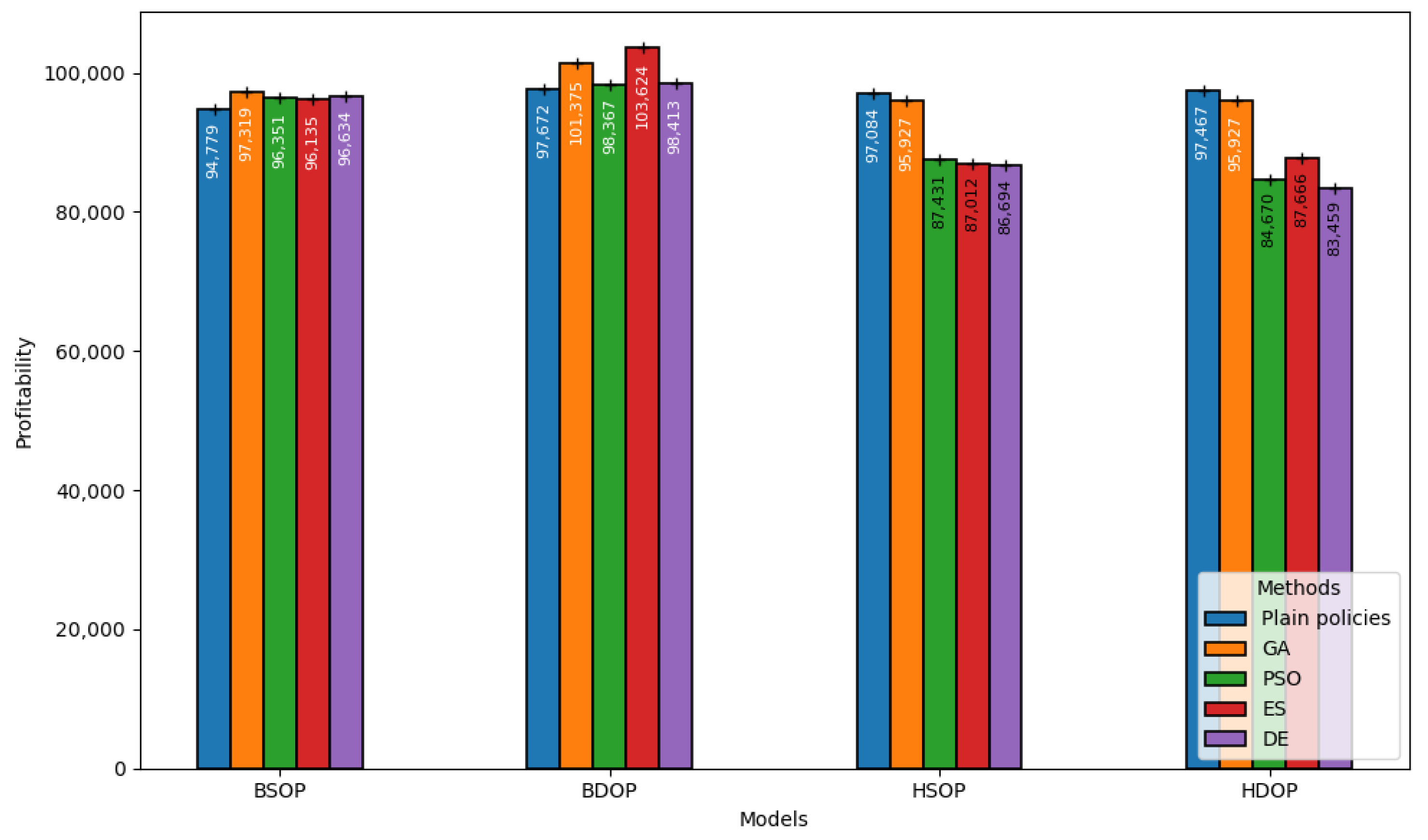
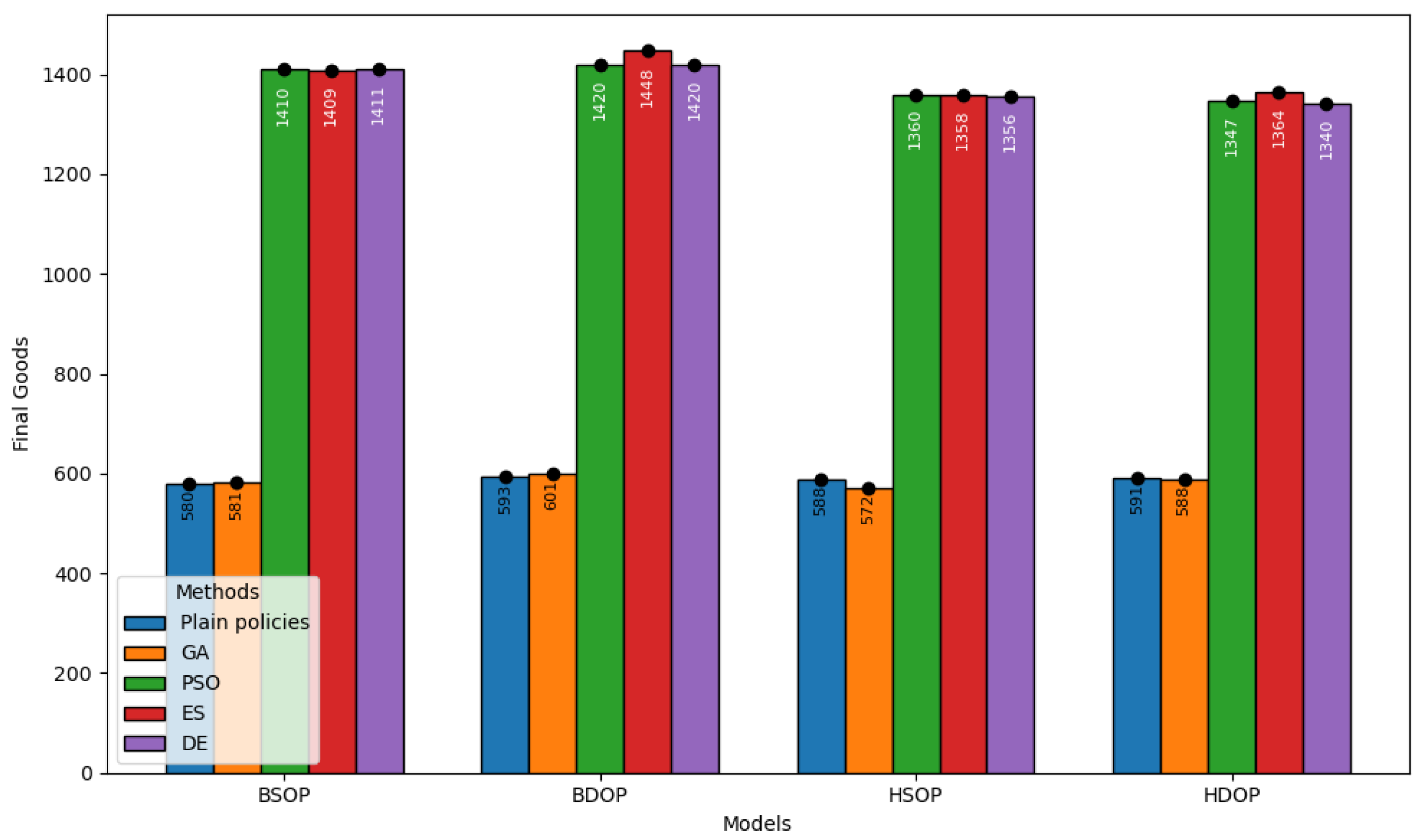
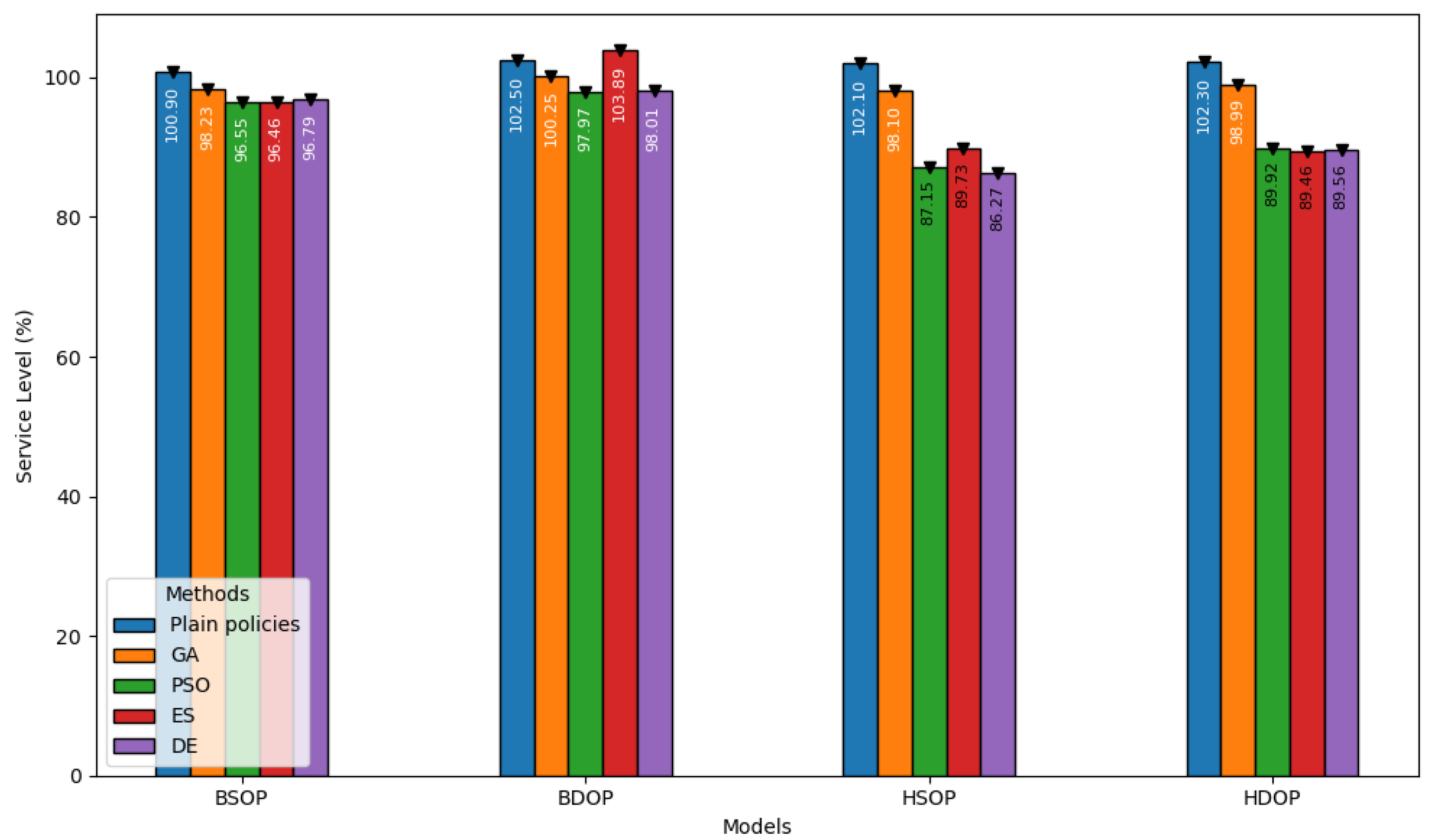
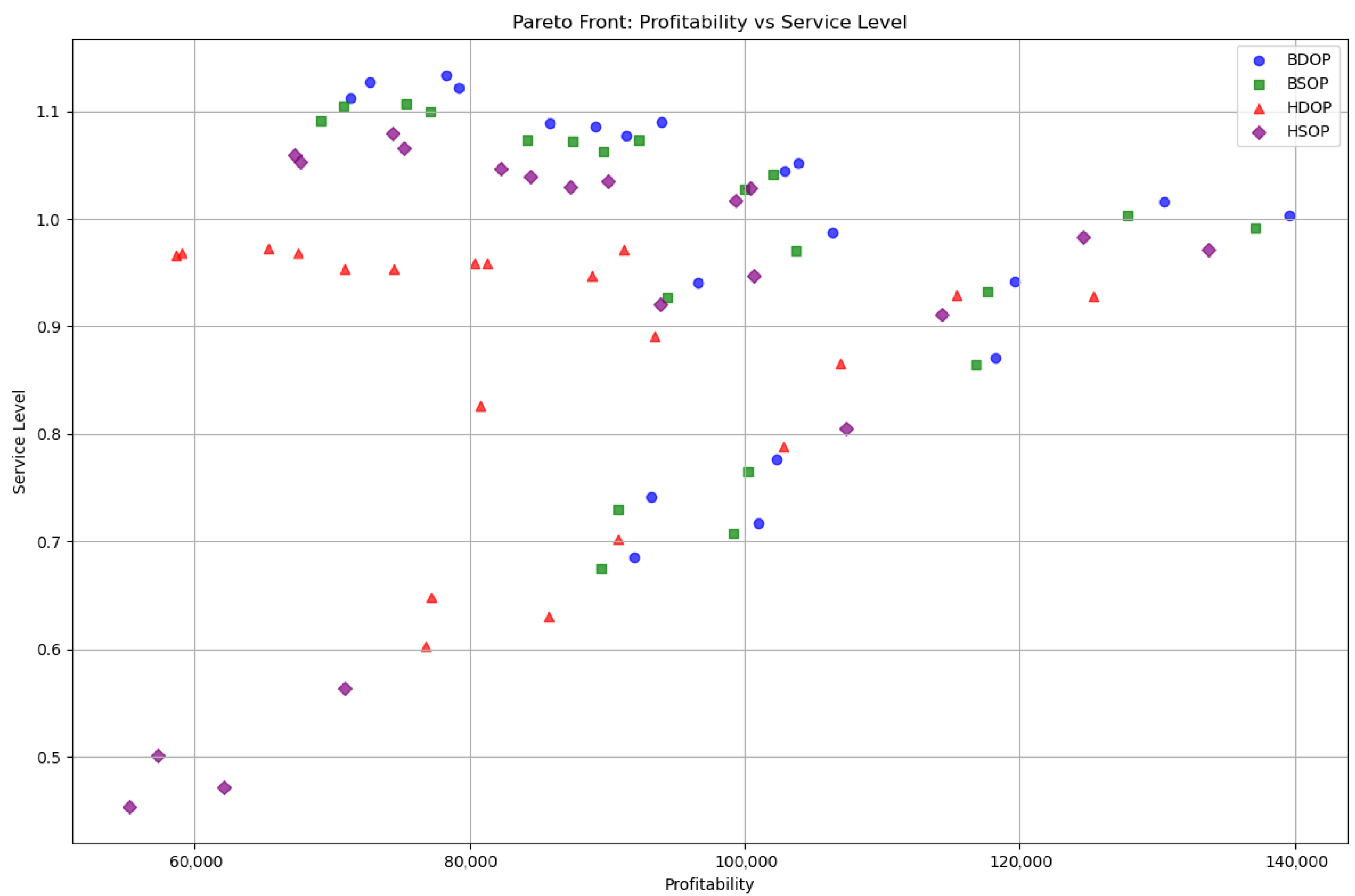

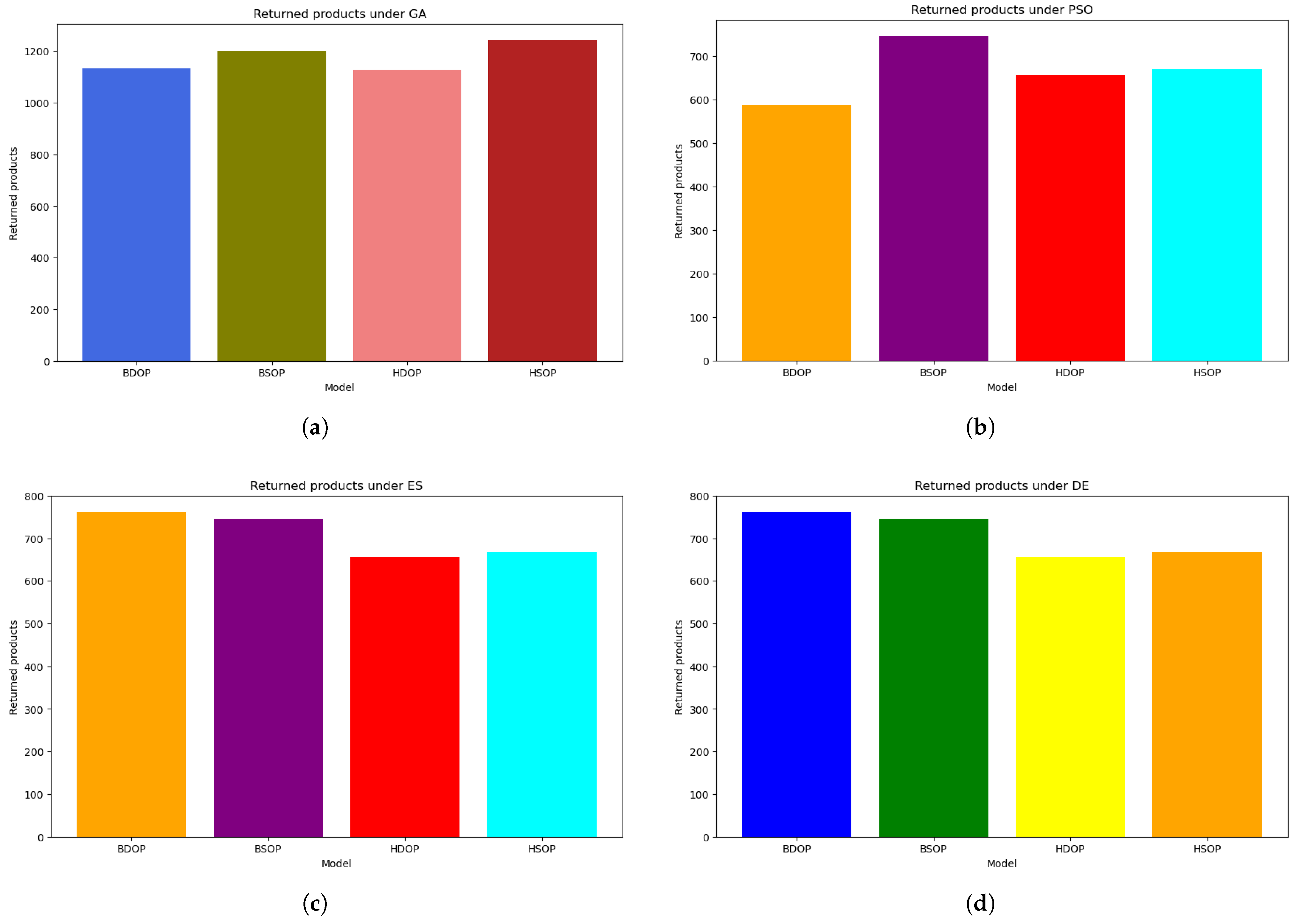
| # | PRO | RAW | REP | MAIN | BREAK | REC | DEM |
|---|---|---|---|---|---|---|---|
| 1 | 2.7 | 3.44 | 12.42 | 10.26 | 4.78 | 5.14 | 4.73 |
| 2 | 2.7 | 3.44 | 12.42 | 10.26 | 4.78 | 5.14 | 5.07 |
| 3 | 2.7 | 3.44 | 12.42 | 10.26 | 4.78 | 5.14 | 6.28 |
| 11 | 5.12 | 5.78 | 10.35 | 8.83 | 7.39 | 8.41 | 4.73 |
| 12 | 5.12 | 5.78 | 10.35 | 8.83 | 7.39 | 8.41 | 5.07 |
| 13 | 5.12 | 5.78 | 10.35 | 8.83 | 7.39 | 8.41 | 6.28 |
| 14 | 5.12 | 5.78 | 10.35 | 8.83 | 7.39 | 8.41 | 7.41 |
| 15 | 5.12 | 5.78 | 10.35 | 8.83 | 7.39 | 8.41 | 8.58 |
| 16 | 6.34 | 5.78 | 10.35 | 8.83 | 8.63 | 9.25 | 4.73 |
| 17 | 6.34 | 5.78 | 10.35 | 8.83 | 8.63 | 9.25 | 5.07 |
| 18 | 6.34 | 5.78 | 10.35 | 8.83 | 8.63 | 9.25 | 6.28 |
| 19 | 6.34 | 5.78 | 10.35 | 8.83 | 8.63 | 9.25 | 7.41 |
| 20 | 6.34 | 5.78 | 10.35 | 8.83 | 8.63 | 9.25 | 8.58 |
| 21 | 4.53 | 4.61 | 11.34 | 9.55 | 6.55 | 7.27 | 6.41 |
| Parameter | Value |
|---|---|
| 17 | |
| 20 | |
| 10 | |
| 13 | |
| 22 | |
| 18 | |
| 37 | |
| 10 | |
| 13 | |
| 22 | |
| 18 | |
| 210.52 | |
| 150.22 | |
| 100.15 | |
| 6.5 | |
| 6.5 | |
| 6.5 | |
| 6.5 | |
| 10.26 | |
| 12.34 | |
| 12.34 |
| Degrees of Freedom | Sum of Squares | Mean Square | F-Statistic | p-Value | |
|---|---|---|---|---|---|
| Group | 3 | 384.9 | < | ||
| Residuals | 116 |
| Comparison | Difference | Lower Confidence Interval | Upper Confidence Interval | Adjusted p-Value |
|---|---|---|---|---|
| ES-DE | −499.43 | −13,323.71 | 12,324.85 | 0.99997 |
| GA-DE | −3699.24 | −16,523.52 | 9125.04 | 0.92934 |
| Plain policies-DE | −2277.61 | −15,101.89 | 10,546.67 | 0.98776 |
| PSO-DE | −94.61 | −12,918.89 | 12,729.67 | 1.00000 |
| GA-ES | −3199.81 | −16,024.09 | 9624.47 | 0.95736 |
| Plain policies-ES | −1778.19 | −14,602.47 | 11,046.09 | 0.99524 |
| PSO-ES | 404.82 | −12,419.46 | 13,229.10 | 0.99999 |
| Plain policies-GA | 1421.63 | −11,402.65 | 14,245.91 | 0.99800 |
| PSO-GA | 3604.63 | −9219.65 | 16,428.91 | 0.93534 |
| PSO-Plain policies | 2183.00 | −10,641.28 | 15,007.28 | 0.98957 |
| Statistics | PSO | ES | DE | GA | Plain Policies |
|---|---|---|---|---|---|
| Mean | 98,111.51 | 97,644.58 | 98,015.03 | 91,481.47 | 94,719.68 |
| Variance | 260,338,594 | 254,616,401 | 261,301,753 | 526,160,505 | 221,618,820 |
| Standard deviation | 16,139.20 | 15,956.43 | 16,163.81 | 22,939.16 | 14,885.20 |
| 95% Lower CI | 93,388.15 | 93,062.02 | 93,422.51 | 85,669.81 | 91,313.27 |
| 95% Upper CI | 102,834.88 | 102,227.15 | 102,607.56 | 97,293.14 | 98,126.10 |
| Computational cost of optimization (in seconds) | 5.692 | 3.241 | 3.736 | 4.491 | N/A |
Disclaimer/Publisher’s Note: The statements, opinions and data contained in all publications are solely those of the individual author(s) and contributor(s) and not of MDPI and/or the editor(s). MDPI and/or the editor(s) disclaim responsibility for any injury to people or property resulting from any ideas, methods, instructions or products referred to in the content. |
© 2025 by the authors. Licensee MDPI, Basel, Switzerland. This article is an open access article distributed under the terms and conditions of the Creative Commons Attribution (CC BY) license (https://creativecommons.org/licenses/by/4.0/).
Share and Cite
Paraschos, P.D.; Papadopoulos, G.; Koulouriotis, D.E. Multi-Objective Evolution and Swarm-Integrated Optimization of Manufacturing Processes in Simulation-Based Environments. Machines 2025, 13, 611. https://doi.org/10.3390/machines13070611
Paraschos PD, Papadopoulos G, Koulouriotis DE. Multi-Objective Evolution and Swarm-Integrated Optimization of Manufacturing Processes in Simulation-Based Environments. Machines. 2025; 13(7):611. https://doi.org/10.3390/machines13070611
Chicago/Turabian StyleParaschos, Panagiotis D., Georgios Papadopoulos, and Dimitrios E. Koulouriotis. 2025. "Multi-Objective Evolution and Swarm-Integrated Optimization of Manufacturing Processes in Simulation-Based Environments" Machines 13, no. 7: 611. https://doi.org/10.3390/machines13070611
APA StyleParaschos, P. D., Papadopoulos, G., & Koulouriotis, D. E. (2025). Multi-Objective Evolution and Swarm-Integrated Optimization of Manufacturing Processes in Simulation-Based Environments. Machines, 13(7), 611. https://doi.org/10.3390/machines13070611







